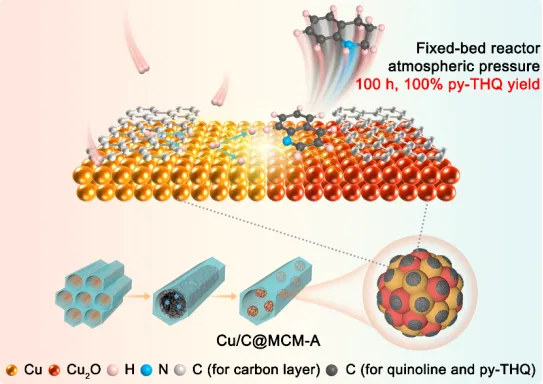1,2,3,4-Tetrahydroquinoline (py-THQ) skeletons are prevalent and important structural motifs in various bioactive substances and natural alkaloids, as well as drug molecules (e.g., virantmycin and aspoquinolones) with antiviral, antifungal, and anticancer activity properties. At present, selective hydrogenation of quinolines is considered a promising approach to produce corresponding compounds due to the great atom economy and simplicity. However, apart from selectivity issues, this direct transformation also involves other challenges such as high reaction energy barriers and potential poisoning by either substrates or their reduced products. Most heterogeneous catalysts in this area with superior performance are noble-metal-based catalysts, (e.g., Pt, Pd, Ru, Rh, Ir, and Au), but their insufficient selectivity, poor tolerance for functional groups, and high price restrict their practical applications. Hence, the development of cheap and earth-abundant non-noble-metal catalysts to achieve efficient conversion of quinolines under moderate conditions is critical for the future of the pharmaceutical, polymer, and agrochemical industries. According to the existing literature, the selective hydrogenation of quinolines is primarily conducted in batch autoclave reactors, which precludes in situ catalyst reduction and causes inevitable exposure to air. Besides, each reaction cycle necessitates many labor-intensive operations. In contrast, the continuous-flow fixed-bed technology can avoid the oxidation of active components and address the recovery issue of supported catalysts. More importantly, fixed-bed systems can break the production restrictions of batch systems and realize the continuous automated production of py-THQ compounds under atmospheric pressure. However, the selective hydrogenation of quinolines in this technology has not been reported.
Recently, Wei Li’s group have managed to synthesize Cu nanoclusters covered with fragmented ultrathin carbon inside the mesochannels of MCM-41. The assembled catalyst (Cu/C@MCM-A) offered 100% conversion of quinoline to py-THQ under exceptionally mild reaction conditions (80 °C and atmospheric pressure) in a continuous-flow fixed-bed reactor. Importantly, this catalyst exhibits a durable stability test over 100 h with a 100% py-THQ yield at 0.3 MPa, outperforming almost all heterogeneous catalysts that we know. Besides, Cu/C@MCM-A shows remarkable hydrogenation activity and chemoselectivity in the partial hydrogenation of other pyridine-like N-heteroarenes and polycyclic aromatic hydrocarbons. In situ characterization attests that the key to catalyst preparation is the etching treatment of precursor impregnated with Cu salts under an oxygen-containing atmosphere. Within the range of 0-21 v/v%, the lower the O2 content, the larger the Cu particle size, and the thicker the carbon layer, leading to a much inferior catalytic activity. Performance studies and theoretical calculations indicate that the Cu–C interface in Cu/C@MCM-A reduces the energy barrier for H2 dissociation. Simultaneously, the ultrathin carbon induces more Cu+ species, and the synergy between it and Cu0 balances rates for activation (and transference) of quinoline and H2, guaranteeing the high selectivity of py-THQ. This work provides valuable insights into the mechanism of formation of active sites in catalysts and opens a unique avenue for the construction of carbon-encapsulated metal clusters in selective hydrogenation. Relevant achievements were published in J. Am. Chem. Soc., 2025. DOI: 10.1021/jacs.5c02289.
